You’ve heard of the Big Five and all of Africa’s other iconic wildlife, from lanky giraffes and sneaky hyenas to the gigantic whales that travel up and down the eastern and western coastlines. However, the continent is also home to all kinds of strange and wonderful African mammals that don’t typically make the headlines.
Some use sensory superpowers to find their prey, while others have developed intriguing behaviours that keep them safe from the elements and predators. So, next time you’re on safari in Africa, ask your guide about these zoological curiosities and discover a side of nature you didn’t even know existed.
Let’s take a look at 10 of Africa’s weirdest mammal species.
Damaraland Mole-Rat
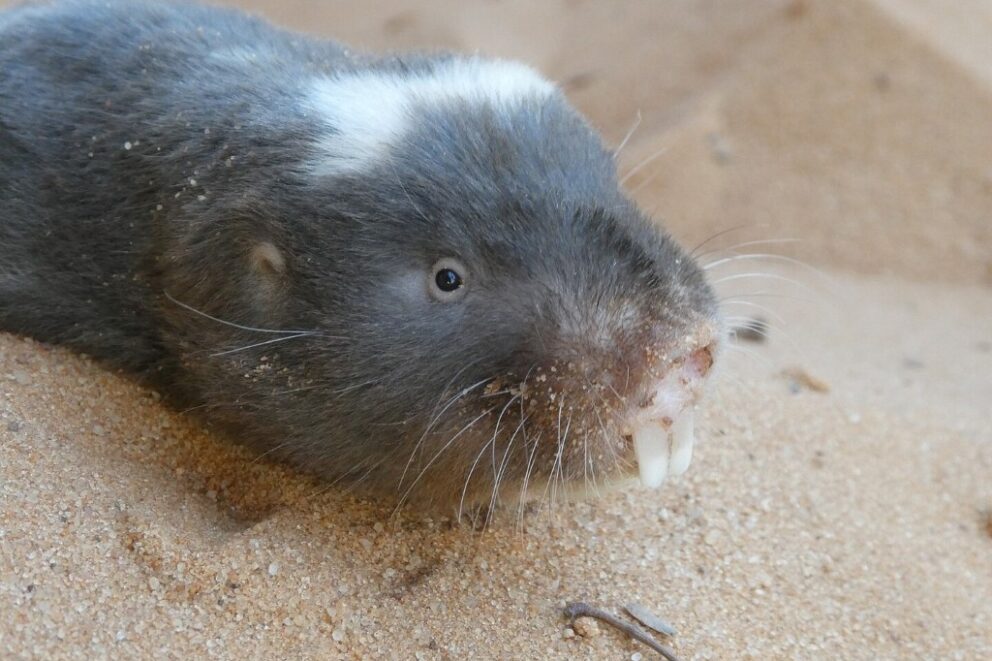
We already know that insects like ants and bees live in colonies where different individuals take on different roles. In zoology, this is called eusociality, and is considered the highest level of organisation of sociality. But did you know that there’s a eusocial mammal, too. In fact, there are only two in the world: the naked mole-rat and its furrier distant cousin, the Damaraland mole-rat.
As its name suggests, the Damaraland mole-rat lives in the Damaraland region that spans northern Namibia and southern Angola. However, it also ranges across much of Botswana, South Africa, Zimbabwe, and Zambia, too. They especially love the red sand of the Kalahari, but they’ll live anywhere where they can find enough food.
Speaking of food, Damaraland mole-rates eat the parts of plants that grow underground, namely bulbs, tubers, and corms. Using their massive front teeth, they dig huge networks of tunnels to access and store food. In fact, some believe that these networks can reach up to a kilometre long.
A single colony of mole-rates can include up to 40 individuals, but around a dozen is more typical for the species. Within this colony, there’s just a single breeding pair. All the other individuals are effectively sterile and will only become fertile if the breeding female dies and the colony disperses, causing them to establish breeding colonies of their own.
Forget the teeth, underground lifestyle, and tiny eyes. This eusocial behaviour is what makes the Damaraland mole-rat one of Africa’s weirdest animals.
Four-Toed Elephant Shrew
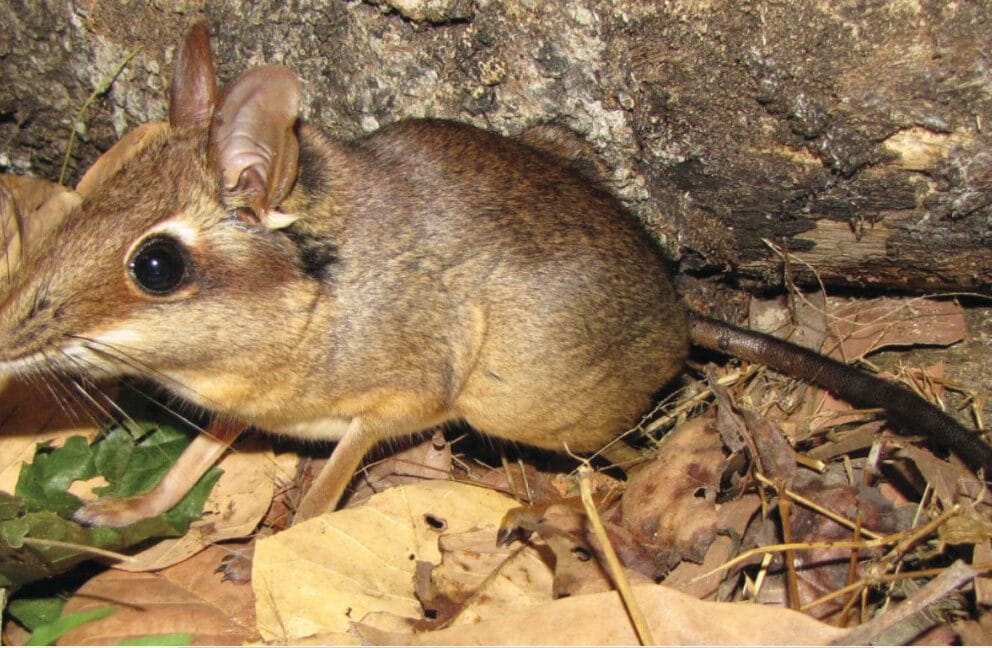
Did you know that alongside the Big Five, South Africa also has a Small Five? Each one shares part of its name with a larger counterpart – like elephant shrews. They’re so-called not for their size, but for their long, flexible snouts that help them sniff out insects and other prey. This feature makes them particularly strange, but the weirdest thing about them is that despite their uncanny resemblance to mice, shrews, and rats, elephant shrews aren’t rodents at all. Instead, they belong to the clade Afrotheria, which also includes elephants, aardvarks, and hyraxes.
Unlike most elephant shrews, the four-toed elephant shrew has four toes on its rear feet. It also has larger eyes and bigger, pointier ears than most other elephant shrews and grows to a maximum weight of 280g. By tiny animal standards, that’s quite big, doing justice to its name. You can find these animals in Central, East, and southern Africa.
But wait – it gets even weirder. Four-toed elephant shrew fights look more like boxing bouts than animal scuffles. The little animals stand on their hind legs and use their front paws to grapple and strike each other, with plenty of squeaking and shrieking thrown in for good measure.
Aardvark
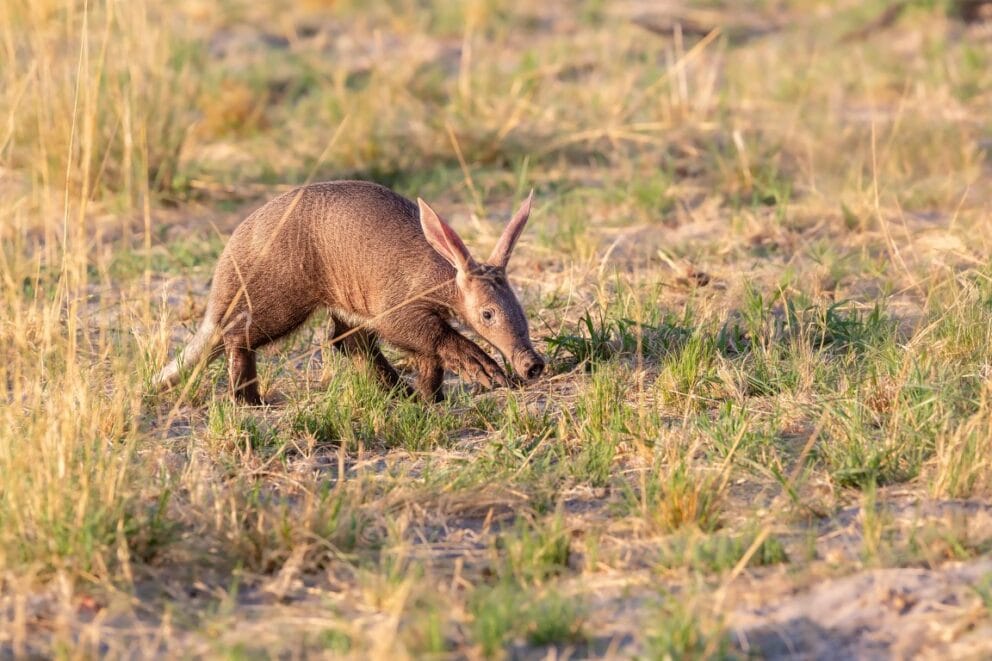
Like the four-toed elephant shrew, the aardvark (lit. “earth pig”) belongs to the Afrotheria clade alongside a rather peculiar collection of species. After all, elephants and hyraxes look nothing alike. However, the aardvark slots right in with this group of misfits, with its elongated pig-like snout, donkey-like ears, and claws that look like they can do serious damage.
Although it closely resembles the anteaters of Central and South America, the nocturnal aardvark is the result of “convergent evolution” and is only very distantly related to them. Nevertheless, it also has a diet of mainly ants and termites and also uses a long, sticky tongue to lap them up by the hundreds.
You can find aardvarks across most of sub-Saharan Africa. The species locates its prey using its weird and wonderful senses: it has nine olfactory bulbs in its nose, more than any other mammal, giving it an incredible sense of smell. Furthermore, its large ears aren’t just for show, either. Once it finds a termite mound or anthill, it uses its hoof-like claws to break through the crust and begins eating insects at a rate of up to 50,000 in a single night.
It also digs its own burrows, which you can often see along the side of the road in sandy rural areas. Aardvarks tend to move on to new burrows after a while, leaving the old ones available for other animals like bat-eared foxes, warthogs, and even African wild dogs.
South African Springhare
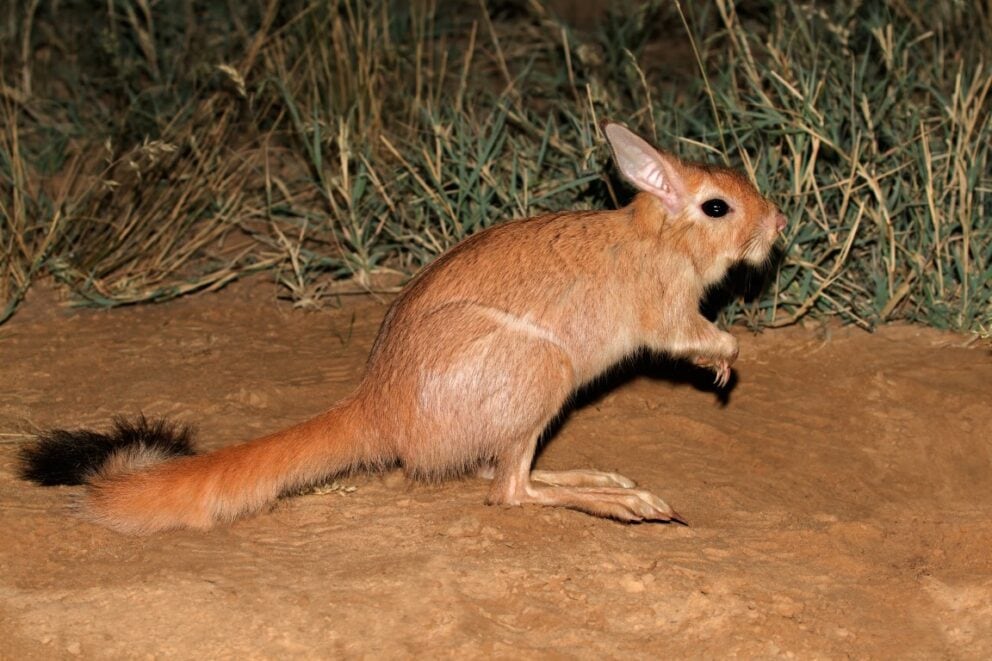
Imagine a hare crossed with a squirrel, and that’s the South African springhare. It’s one of Africa’s weirdest-looking animals, and depending on your perspective, it could be cute, scruffy, or downright freaky.
It looks a lot like a rabbit or a hare, but it’s actually a rodent and can be found in parts of the Democratic Republic of Congo, Angola, Zambia, Zimbabwe, Namibia, Mozambique, Botswana, and South Africa. It prefers sandy areas where it can burrow into the soil, using its legs to excavate while it gnaws through tough roots with its teeth. It mostly eats plants, but it can sometimes hunt insects and scavenge carrion.
As mentioned, the South African springhare looks like a mish-mash of different animals. If anything, it looks a lot like a kangaroo, complete with large hind legs that can propel it up to two metres, a long tail, and short front legs. Up close, its head looks somewhat like that of a squirrel, except with much larger eyes. Including the bushy tail, it can grow up to 80 cm long and weigh up to 3.5 kg.
However, the springhare’s odd looks aren’t its weirdest attribute. In 2021, researchers published evidence that alongside its East African cousin, the South African springhare is one of the only mammals in the world capable of biofluorescence. Certain parts of its fur absorb light, convert it into a different kind of light, and emit it again.
Ground Pangolin
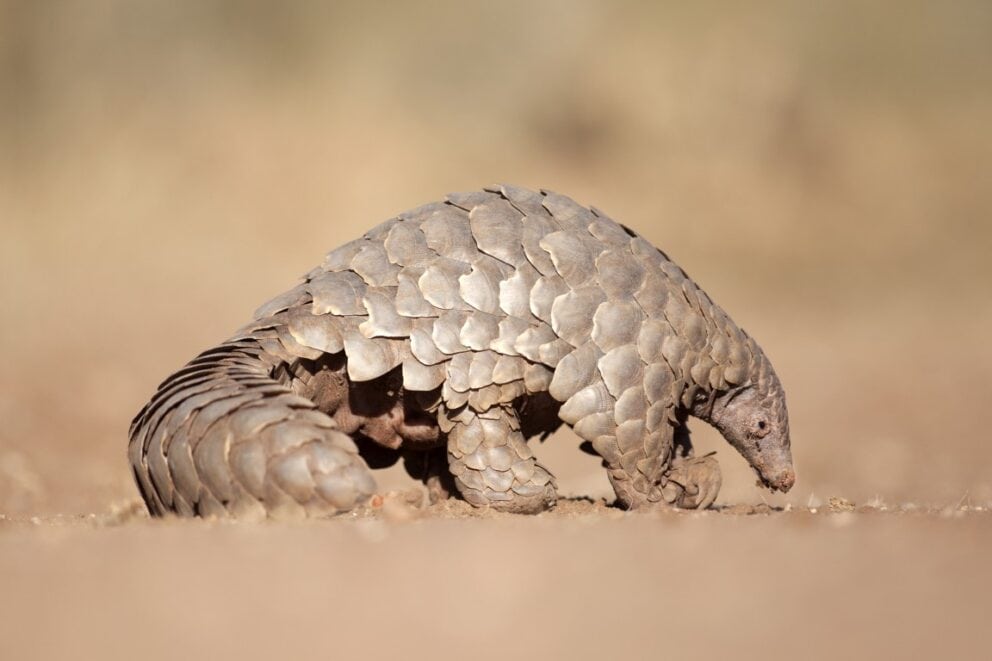
Meet one of Africa’s most prehistoric-looking creatures: the ground pangolin. This scaly, ant-eating oddity is perhaps one of the continent’s better-known weird animals, but sadly, a lot of this has to do with the ongoing exploitation of pangolins for bushmeat and traditional medicine. In fact, the International Union for the Conservation of Nature lists the ground pangolin as “Vulnerable”, making it a major target of conservation efforts.
The ground pangolin lives in savannah woodland areas from South Africa northward all the way to Sudan and Chad. However, it’s absent from much of Central and West Africa, where the giant pangolin takes its place. The ground pangolin is a giant in its own right, reaching up to 1.6 m long including the tail and weighing up to 27 kg. Incredibly, its scales can make up around 20% of its total body weight.
Despite looking like a tank, the pangolin does have one vulnerable spot: its underside. When it feels threatened, it will roll up into a ball, using its keratin scales as an effective barrier. Adding to its ancient look, the ground pangolin mostly walks on its hind legs, giving it a dinosaur-like appearance. It uses its long front claws to break into termite nests and captures insects with its long, sticky tongue – so long, in fact, that it’s actually longer than the pangolin itself.
Weirdly, ground pangolins lack teeth. Instead, their muscular stomachs have hard spines that crush insects with a little help from small stones that the animal swallows for this exact purpose. Other weird characteristics include a tail that doubles as a weapon, a habit of rolling in dung, and the ability to spew foul-smelling acid from its rear end to chase off predators.
Dugong
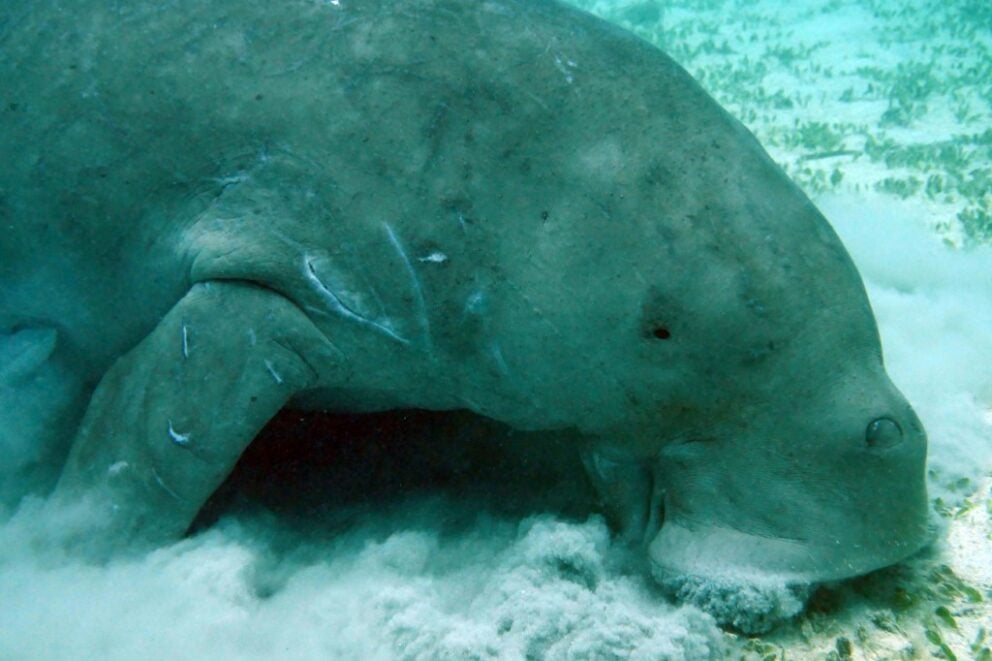
The dugong, also known as the sea cow, is the last remaining sirenian in the Indo-West Pacific region. The largest populations live along the northern coast of Australia, but several smaller populations still exist along the East African coast. The most famous of these populations is the 120-strong group that lives in the Bazaruto Archipelago in Mozambique. They’re also members of the Afrotheria clade, meaning they’re far more closely related to elephants than they are to other marine mammals like whales and seals.
Despite this, it has a very dolphin-like tail fluke and flippers. It also has sparse hairs all over its body that might play a role in tactile feedback. This is most visible around the muzzle, which also features a highly muscular upper lip that helps it to eat its favourite food, seagrass. Weirdly for most mammals, but not for marine mammals, its nostrils are on top of its head. It has poor eyesight, so it relies on smell to find food and hearing to keep tabs on predators.
However, because it can weigh up to a tonne, its only real threat comes from large sharks, orcas, and humans. Habitat destruction is wreaking havoc on seagrass meadows, which once spanned huge areas throughout its range. It’s also vulnerable to collisions with boat propellers and hunting for meat and blubber.
Another weird feature is its solid bones, many of which contain little to no bone marrow. It’s thought that this helps the dugong stay just below the water surface. It also has blood that clots remarkably quickly and elongated kidneys that help it survive in its saltwater home.
Bat-Eared Fox
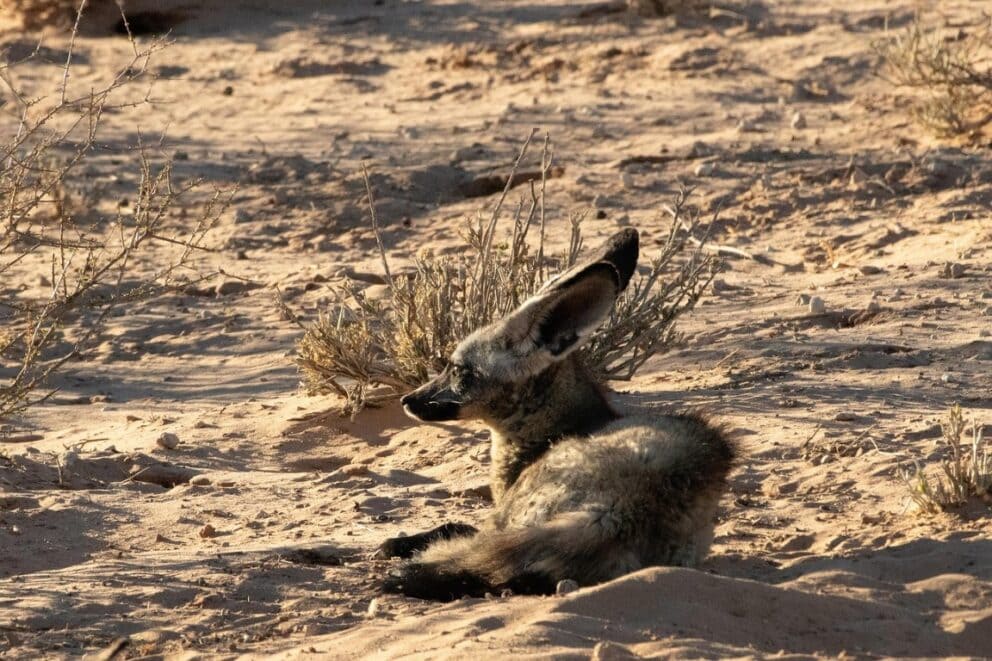
The first thing you notice about the bat-eared fox is its enormous ears, which can be up to 13 cm long. Considering that the entire fox grows to just 66 cm in length, it has some of the largest ears proportionate to its size of any canid. This curious fox is found across much of East and southern Africa, making its home in underground dens.
Aside from its looks, it’s the bat-eared fox’s diet that makes it a weird member of the canid family. As a matter of fact, it’s the only genuinely insectivorous canid and mostly feeds on harvester termites. However, it also eats other insects, as well as small animals and eggs.
Unsurprisingly, they use their ears to locate prey – even if the termites are hiding underground. They’re so good at finding harvester termites, in fact, that some people use them to control termites on their farms.
Perhaps the weirdest thing about the bat-eared fox is that it doesn’t really drink water. Remarkably, it gets all the water it needs from the insects it eats. Its ears also serve a secondary purpose: in the hot, dry areas where it lives, large ears help it to regulate its body temperature. Finally, it has incredible jaw musculature that allows it to open and close its mouth up to five times per second!
Lowland Streaked Tenrec
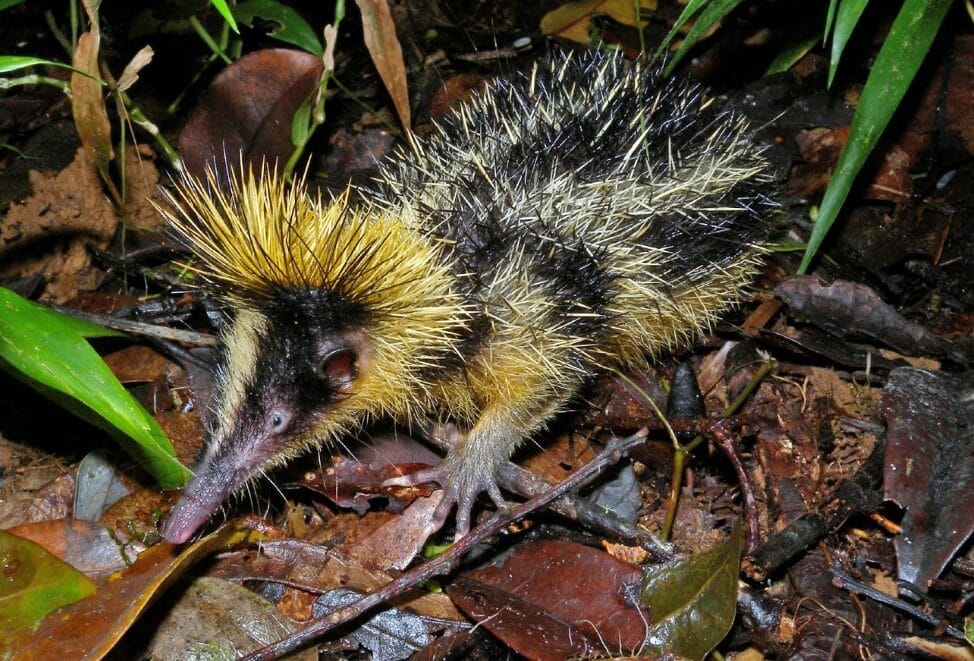
When it comes to weird sounds, the animal kingdom has some interesting performers. Take the humble cricket, for instance. These little insects rub their leathery forewings together to produce the distinctive “chirping” noise that you either love or hate. But did you know that Madagascar’s lowland streaked tenrec can do something similar?
Like elephant shrews, aardvarks, and dugongs, tenrecs are members of the Afrotheria clade, so despite looking like rodents, they aren’t. You can only find them in Madagascar, where there are 31 extant species, including the lowland streaked tenrec. One of the “spiny tenrecs”, it has quills all over its body that keep predators at bay. That’s quite important when you only grow up to 172 mm long!
It also has a yellow or brown stripe that runs along the length of its body, hence the name. Its quills are concentrated around its head, giving it a kind of lion’s mane. But what makes the lowland streaked tenrec so unique and weird? Well, it can rub its quills together or point them forward and vibrate them to produce high-frequency sounds. Scientists believe that the tenrec does this to ward off predators or to communicate with its offspring.
This makes it the only mammal in the world that uses stridulation to produce sound. Other weird characteristics include its ability to hibernate – even though it lives in a tropical habitat – and its tendency to headbutt other animals.
Aye-Aye
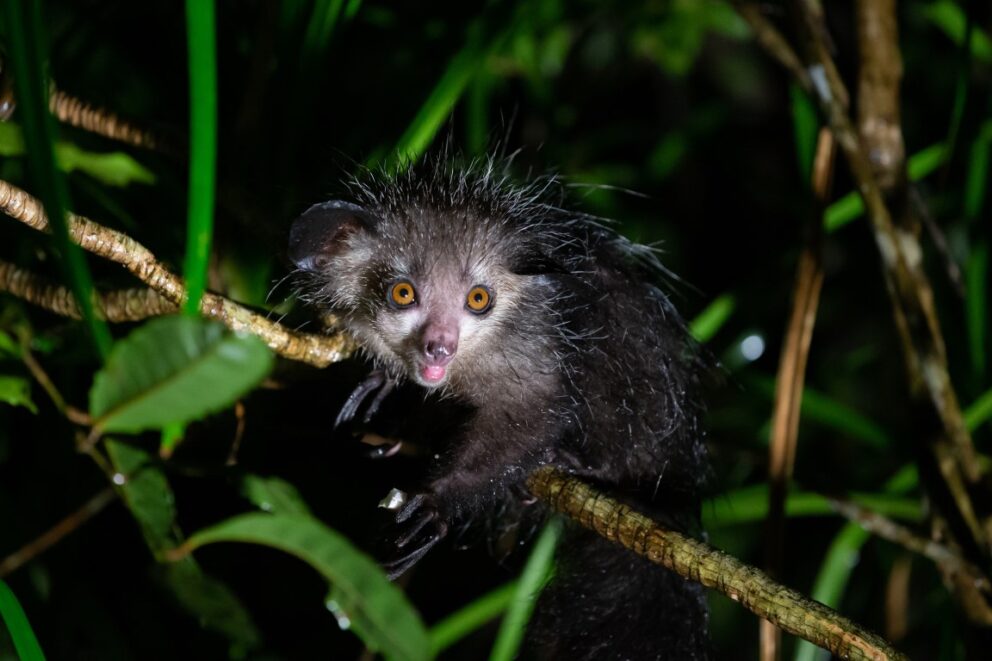
Meet Madagascar’s most mysterious inhabitant: the aye-aye. It’s by long and away the weirdest lemur on the island and it’s also the planet’s largest nocturnal primate. With its striking eyes, long, skeletal fingers, and bat-like ears, it’s certainly a strange-looking animal. Some Malagasy people consider it an omen of death, so sadly, it faces ongoing persecution from rural communities.
The aye-aye’s weird features aren’t just for show. Its large eyes help it to see in the dark, but it’s the lemur’s feeding habits that draw the most attention. It’s one of just a handful of animals in the world that employs “percussive foraging” to find its prey, insect grubs. When it taps its long, thin third finger along tree bark, the sound waves reverberate into its complex ears, allowing it to precisely echolocate its prey. Then, it uses its rodent-like teeth to create a small hole, and fishes the grub out with the help of the hooked nail on the very same finger. Less glamorously, it also uses its weird fingers to pick its nose and eat its own mucous.
Females feed their offspring from two nipples found near the groin. During this time, males become subordinate to females, probably to give them better access to food. Aye-ayes spend most of their lives in trees, using vertical jumps to travel up to four kilometres each night.
Sadly, like much of Madagascar’s wildlife, the aye-aye faces critical threats like widespread deforestation and persecution by farmers. The IUCN lists it as endangered, so there’s work to be done to preserve this weird species.
Southern Right Whale
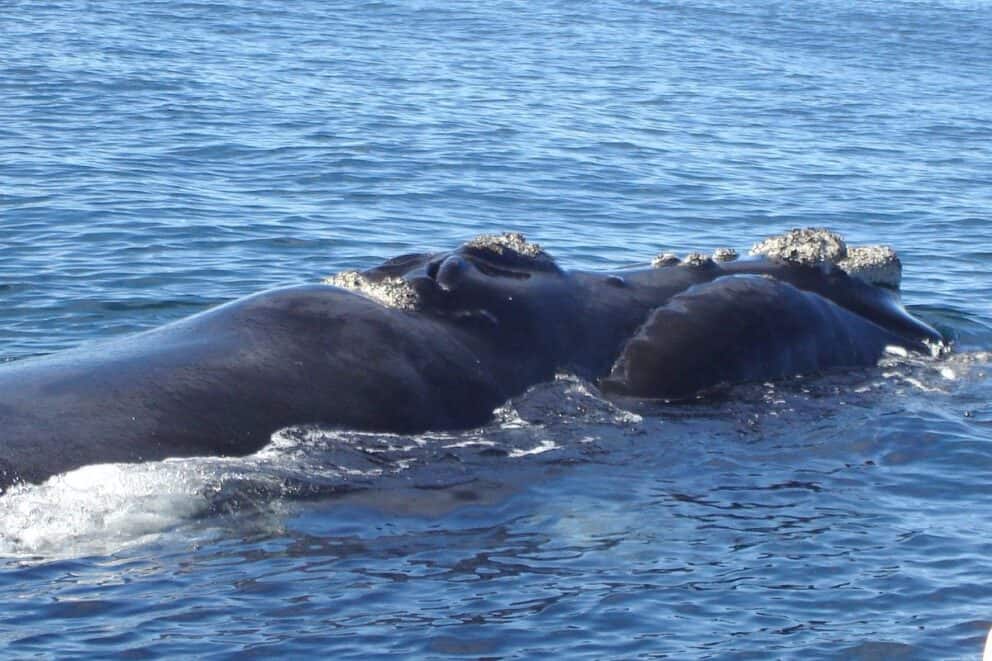
Few creatures demand as much respect, admiration, and sheer awe as whales. Africa is home to dozens of species of “cetaceans”, the family that includes both whales and dolphins, but few are as strange as the barnacled southern right whale. Let’s start with its name, which, in fact, has nothing to do with direction. Some speculate that whalers labelled it the “right” whale to hunt, because historically, it was quite easy to hunt and yielded plenty of blubber. However, historians argue that the word could simply mean “true”, “correct”, referring to its typical whale-like appearance.
Names aside, the southern right whale is a magnificent mammal. Males can grow up to 18 m long and weigh up to 90 tonnes, and they also have the unusual honour of having the animal kingdom’s largest testicles. Its weirdest features are its upside down smile and large callosities on its head. These large, rough, white patches aren’t barnacles, as some people believe, but are actually patches of hardened skin infested by thousands of crustaceans called whale lice.
Southern right whales feed by “skimming” water near the surface. As water enters the mouth, the whale strains it through its massive baleen plates to filter out krill, plankton, and small fish. In summer, you can find them feeding in the icy waters around Antarctica. When winter arrives, they migrate northward to their breeding grounds in South Africa. The town of Hermanus is one of the best places to see them as they make their way to Walker Bay to calve.
There are many reasons to celebrate Africa’s weirdest animals, not least because many of them are icons of their respective countries. Some represent the absolute extremes of animal evolution, while others continue to teach us things about the animal kingdom that we never knew were possible.
Each of these ten species has a fascinating story, but to truly appreciate just how weird they are, you’re going to have to see them up close. You may have to go out of your way to see them, but they’re worth adding to your wildlife wishlist for your next African safari adventure. After all, it’s their weirdness that makes them so incredible.








 Copy Link
Copy Link
 Share on LinkedIn
Share on LinkedIn
 Share on Facebook
Share on Facebook
 Blog List
Blog List









Written by Micky Baker
• Travel Writer